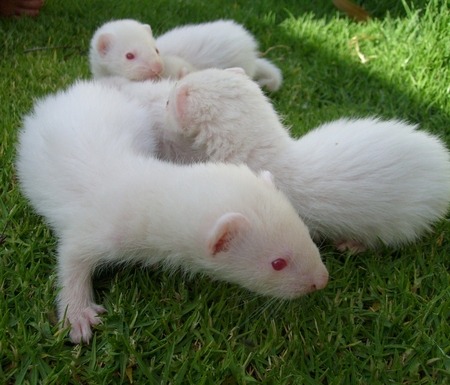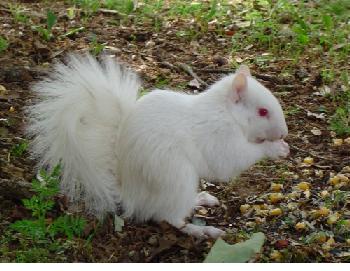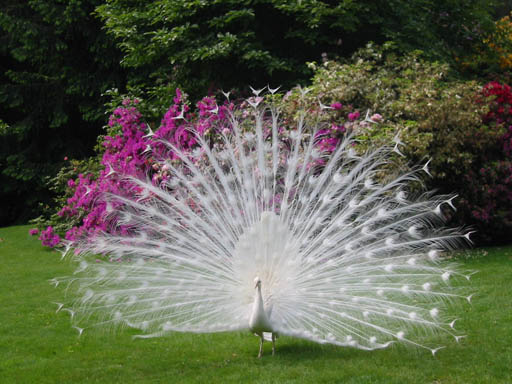|
|
|---|
Wednesday, April 27, 2011
Mom just read a book that has bonobos in it, so she said maybe I should write about them in my blog. The name of the book is Ape House, and it was written by Sara Gruen. This same writer also wrote Water for Elephants, which is now a movie that is playing right here in town, and Mom wants to go see it soon.
Anyway, the apes in Ape House are bonobos, which are sometimes also called pygmy chimpanzees or dwarf chimpanzees. There are humans in the book, too, and there is a pit bull named Booger. I think that any book with a dog in it is a good book. Mom said she liked reading the book, even though there was some stuff in it that was a little goofy. And mostly she thought the bonobos were interesting, so now I will tell you what I learned about them when I did my research.
Bonobos are Great Apes. Other Great Apes include orangutans, chimpanzees, gorillas, and humans. Apes are different from monkeys because they don't have tails, like monkeys do. Also, they have shoulder joints that make it so they can swing from vine to vine, like Tarzan. Monkeys just have to run along the tops of the trees, and what fun is that?
Chimpanzees and bonobos probably have the same ancestors, and they evolved in the Congo, in central Africa, which is the same place that my distant cousins, the basenjis live. Anyway, a long, long time ago, the Congo River formed, and it got to be a really big river that the chimpanzees couldn't cross because they are not very good swimmers. So the chimps on the south side of the Congo became bonobos, and the chimps on the north side became what we call the common chimpanzee.
The name bonobo might have come from the Bantu language, where it means "chimpanzee" or "ancestor." Or the name might come from the town of Bolobo, on the Congo River, and somebody spelled it wrong.
Bonobos are smaller and more slender than chimpanzees. They have longer legs and skinnier necks, and they aren't as burly-looking. Their backs are straighter, so when they are walking upright -- which they do about 25% of the time -- they look more like humans. They have black faces with pink lips, small ears, wide noses, and long hair that just naturally parts in the middle.
The favorite food of bonobos is fruit, but they also eat leaves and meat from small animals such as flying squirrels and invertebrates. They even sometimes eat smaller primates.
But what's really interesting about bonobos is that they never get violent and kill each other, like chimpanzees and humans do. Researchers have been trying to figure out for years why bonobos are so nice and peaceful, and they have come up with several reasons.
One reason is that in the Congo, there was always lots of food, so bonobos didn't have to compete for it, and they could share their food without having to go hungry. Also the bonobos have a matriarchal society, which means that GIRLS RULE! The female bonobos are good buddies with each other, so they can dominate the males. A young male bonobo has to be introduced to bonobo society by his mother.
But the very most important reason that bonobos seem to get along so well with each other is that they have lots of sex. Any time they get excited or stressed about something, they just have sex, and then they feel calm and happy again. There are lots of kinds of sex among the bonobos: males with females, females with females, or males with males. They might do it face-to-face or orally. It's just kind of a fun, quick thing they do, and not a big deal. Plus it's usually not about making baby bonobos.
Bonobos are really smart, and some of them have been taught American Sign Language so that they can talk to people. Also they can use computers that have pictures on them that the bonobos can push to communicate. Several bonobos live in a place in Des Moines called the Great Ape Trust, and the researchers there play with the bonobos and study them. Before Ms. Gruen wrote Ape House, she spent some time at the Great Ape Trust. The bonobos in the book and maybe also the researchers in the book are based on the ones she met in Des Moines.
Meanwhile, in the Democratic Republic of Congo, people are trying to save the wild bonobos, who are ENDANGERED. There might be 10,000 bonobos left in the wild, but no one knows for sure. In the DRC, there is a lot of fighting, so apes get killed for their meat. And also their habitat gets destroyed.
One group that is working to save the bonobos is the Bonobo Conservation Initiative. The BCI has offices in the U.S. and also in the DRC, and they are trying to get local communities to help protect bonobos and the rainforest. The way they do this is by educating people and teaching them better ways to farm the land so that more forests don't get cut down.
I wish we had a bonobo at our house to play with. Mom says we couldn't have just one, though, because it would get too lonely and not have anybody to have sex with. And then Mom said she can't really afford more animals and more vet bills, not to mention having to buy a bunch of play equipment and toys for our bonobos, if we had them. So I guess this means we won't be getting any bonobos any time soon, and I think that is just really sad.
Anyway, the apes in Ape House are bonobos, which are sometimes also called pygmy chimpanzees or dwarf chimpanzees. There are humans in the book, too, and there is a pit bull named Booger. I think that any book with a dog in it is a good book. Mom said she liked reading the book, even though there was some stuff in it that was a little goofy. And mostly she thought the bonobos were interesting, so now I will tell you what I learned about them when I did my research.
Bonobos are Great Apes. Other Great Apes include orangutans, chimpanzees, gorillas, and humans. Apes are different from monkeys because they don't have tails, like monkeys do. Also, they have shoulder joints that make it so they can swing from vine to vine, like Tarzan. Monkeys just have to run along the tops of the trees, and what fun is that?
Chimpanzees and bonobos probably have the same ancestors, and they evolved in the Congo, in central Africa, which is the same place that my distant cousins, the basenjis live. Anyway, a long, long time ago, the Congo River formed, and it got to be a really big river that the chimpanzees couldn't cross because they are not very good swimmers. So the chimps on the south side of the Congo became bonobos, and the chimps on the north side became what we call the common chimpanzee.
The name bonobo might have come from the Bantu language, where it means "chimpanzee" or "ancestor." Or the name might come from the town of Bolobo, on the Congo River, and somebody spelled it wrong.
Bonobos are smaller and more slender than chimpanzees. They have longer legs and skinnier necks, and they aren't as burly-looking. Their backs are straighter, so when they are walking upright -- which they do about 25% of the time -- they look more like humans. They have black faces with pink lips, small ears, wide noses, and long hair that just naturally parts in the middle.
The favorite food of bonobos is fruit, but they also eat leaves and meat from small animals such as flying squirrels and invertebrates. They even sometimes eat smaller primates.
But what's really interesting about bonobos is that they never get violent and kill each other, like chimpanzees and humans do. Researchers have been trying to figure out for years why bonobos are so nice and peaceful, and they have come up with several reasons.
One reason is that in the Congo, there was always lots of food, so bonobos didn't have to compete for it, and they could share their food without having to go hungry. Also the bonobos have a matriarchal society, which means that GIRLS RULE! The female bonobos are good buddies with each other, so they can dominate the males. A young male bonobo has to be introduced to bonobo society by his mother.
But the very most important reason that bonobos seem to get along so well with each other is that they have lots of sex. Any time they get excited or stressed about something, they just have sex, and then they feel calm and happy again. There are lots of kinds of sex among the bonobos: males with females, females with females, or males with males. They might do it face-to-face or orally. It's just kind of a fun, quick thing they do, and not a big deal. Plus it's usually not about making baby bonobos.
When scientists looked inside the brains of bonobos, they found out that the parts of the brain that make you feel sad because somebody else is upset or distressed were bigger than those brain parts in chimps. So this might be another reason why these apes are so peaceful and loving.
Bonobos are really smart, and some of them have been taught American Sign Language so that they can talk to people. Also they can use computers that have pictures on them that the bonobos can push to communicate. Several bonobos live in a place in Des Moines called the Great Ape Trust, and the researchers there play with the bonobos and study them. Before Ms. Gruen wrote Ape House, she spent some time at the Great Ape Trust. The bonobos in the book and maybe also the researchers in the book are based on the ones she met in Des Moines.
Meanwhile, in the Democratic Republic of Congo, people are trying to save the wild bonobos, who are ENDANGERED. There might be 10,000 bonobos left in the wild, but no one knows for sure. In the DRC, there is a lot of fighting, so apes get killed for their meat. And also their habitat gets destroyed.
One group that is working to save the bonobos is the Bonobo Conservation Initiative. The BCI has offices in the U.S. and also in the DRC, and they are trying to get local communities to help protect bonobos and the rainforest. The way they do this is by educating people and teaching them better ways to farm the land so that more forests don't get cut down.
I wish we had a bonobo at our house to play with. Mom says we couldn't have just one, though, because it would get too lonely and not have anybody to have sex with. And then Mom said she can't really afford more animals and more vet bills, not to mention having to buy a bunch of play equipment and toys for our bonobos, if we had them. So I guess this means we won't be getting any bonobos any time soon, and I think that is just really sad.
0 Comments:
Subscribe to:
Post Comments (Atom)






















